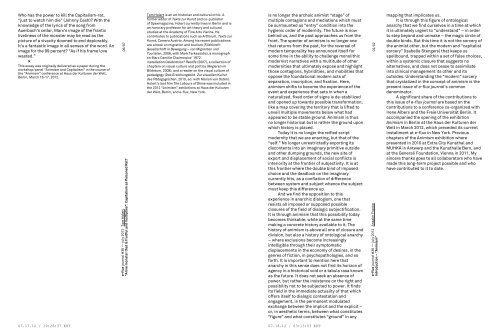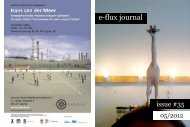Create successful ePaper yourself
Turn your PDF publications into a flip-book with our unique Google optimized e-Paper software.
Who has the power to kill the Capitalism-rat,<br />
“just to watch him die” (Johnny Cash)? With the<br />
knowledge of the lyrics of the song from<br />
Auerbach’s cellar, Marx’s image of the frantic<br />
liveliness of the monster may be read as the<br />
picture of a vivacity doomed to end deplorably.<br />
It’s a fantastic image in all senses of the word. An<br />
image for the 99 percent? “As if his frame love<br />
wasted.”<br />
×<br />
This essay was originally delivered as a paper during the<br />
workshop/panel “<strong>Animism</strong> and Capitalism” in the course of<br />
the “<strong>Animism</strong>” conference at Haus der Kulturen der Welt,<br />
Berlin, March 16-17, 2012.<br />
07.17.12 / 19:26:37 EDT<br />
06/07<br />
e-flux journal #36 — july 2012 Tom Holert<br />
“A live monster that is fruitful and multiplies”: Capitalism as Poisoned Rat?<br />
Tom Holert is an art historian and cultural critic. A<br />
former editor of Texte zur Kunst and co-publisher<br />
of Spexmagazine, Holert currently lives in Berlin and is<br />
an honorary professor for art theory and cultural<br />
studies at the Academy of Fine Arts Vienna. He<br />
contributes to publications such as Artforum, Texte zur<br />
Kunst, Camera Austria. Among his recent publications<br />
are a book on migration and tourism (Fliehkraft:<br />
Gesellschaft in Bewegung – von Migranten und<br />
Touristen, 2006, with Mark Terkessidis), a monograph<br />
on Marc Camille Chaimowicz' 1972<br />
installation Celebration? Realife (2007), a collection of<br />
chapters on visual culture and politics (Regieren im<br />
Bildraum, 2008), and a reader on the visual culture of<br />
pedadgogy (Das Erziehungsbild. Zur visuellen Kultur<br />
des Pädagogischen, 2010, ed. with Marion von Osten).<br />
Holert's last film The Labours of Shine was included in<br />
the 2012 “<strong>Animism</strong>” exhibitions at Haus der Kulturen<br />
der Welt, Berlin, and e-flux, New York.<br />
is no longer the archaic animist “stage” of<br />
multiple contagions and mediations which must<br />
be surmounted as “entry” condition into the<br />
hygienic order of modernity. The future is now<br />
behind us, and the past approaches us from the<br />
front. The specter of animism is no longer one<br />
that returns from the past, for the reversal of<br />
modern temporality has announced itself for<br />
some time in the ability to challenge monolithic<br />
modernist narratives with a multitude of other<br />
modernities that ultimately expose and highlight<br />
those contagions, hybridities, and mobilities that<br />
oppose the foundational modern acts of<br />
separation, inscription, and fixation. Here,<br />
animism shifts to become the experience of the<br />
event and experience that sets in when a<br />
naturalized, fixed order of signs is de-stabilized<br />
and opened up towards possible transformation,<br />
like a map covering the territory that is lifted to<br />
unveil multiple movements below what had<br />
appeared to be stable ground. <strong>Animism</strong> is thus<br />
no longer historical but is rather the ground upon<br />
which history is placed.<br />
Today it is no longer the reified script<br />
modernity that we are enacting, but that of the<br />
“self.” No longer unrestrictedly exporting its<br />
discontents into an imaginary primitive outside<br />
and other dumping grounds, the new site of<br />
export and displacement of social conflicts is<br />
interiority at the frontier of subjectivity. It is at<br />
this frontier where the double bind of imposed<br />
choice and the deadlock on the imaginary<br />
currently hits, as a conflation of difference<br />
between system and subject whence the subject<br />
must keep this difference up.<br />
And we find the opposition to this<br />
experience in anarchic dialogism, one that<br />
resists all imposed or supposed possible<br />
closures of the field of dialogic subjectification.<br />
It is through animism that this possibility today<br />
becomes thinkable, while at the same time<br />
making a concrete history available to it. The<br />
history of animism is above all one of closure and<br />
division, but also a history of ontological anarchy<br />
– where exclusions become increasingly<br />
intelligible through their symptomatic<br />
displacements in the economy of desires, in the<br />
genres of fiction, in psychopathologies, and so<br />
forth. It is important to mention here that<br />
anarchy in this sense does not find its horizon of<br />
agency in a historical void or a tabula rasa known<br />
as the future. It does not seek an absence of<br />
power, but rather the insistence on the right and<br />
possibility not to be subjected to power. It finds<br />
its field in the immediate actuality of that which<br />
offers itself to dialogic contestation and<br />
engagement, in the permanent modulated<br />
exchange between the implicit and the explicit –<br />
or, in aesthetic terms, between what constitutes<br />
“figure” and what constitutes “ground” in any<br />
07.18.12 / 03:13:53 EDT<br />
02/02<br />
e-flux journal #36 — july 2012 Anselm Franke<br />
Introduction – “<strong>Animism</strong>”<br />
mapping that implicates us.<br />
It is through this figure of ontological<br />
anarchy that we find ourselves in a time at which<br />
it is ultimately urgent to “understand” – in order<br />
to step beyond and unmake – the magic circle of<br />
double binds. But this time it is not the sorcery of<br />
the animist other, but the modern and “capitalist<br />
sorcery” (Isabelle Stengers) that keeps us<br />
spellbound, trapped within a set of false choices,<br />
within a systemic closure that suggests no<br />
alternatives, and does not cease to assimilate<br />
into clinical management its other and its<br />
outsides. Understanding the “modern” sorcery<br />
that crystalized in the concept of animism is the<br />
present issue of e-flux journal’s common<br />
denominator.<br />
A significant share of the contributions to<br />
this issue of e-flux journal are based on the<br />
contributions to a conference co-organized with<br />
Irene Albers and the Freie Universität Berlin. It<br />
accompanied the opening of the exhibition<br />
<strong>Animism</strong> in Berlin at the Haus der Kulturen der<br />
Welt in March 2012, which preceded its current<br />
installment at e-flux in New York. Previous<br />
chapters of the <strong>Animism</strong> exhibition where<br />
presented in 2010 at Extra City Kunsthal and<br />
MUHKA in Antwerp and the Kunsthalle Bern, and<br />
at the Generali Foundation, Vienna in 2011. My<br />
sincere thanks goes to all collaborators who have<br />
made this long-term project possible and who<br />
have contributed to it to date.









